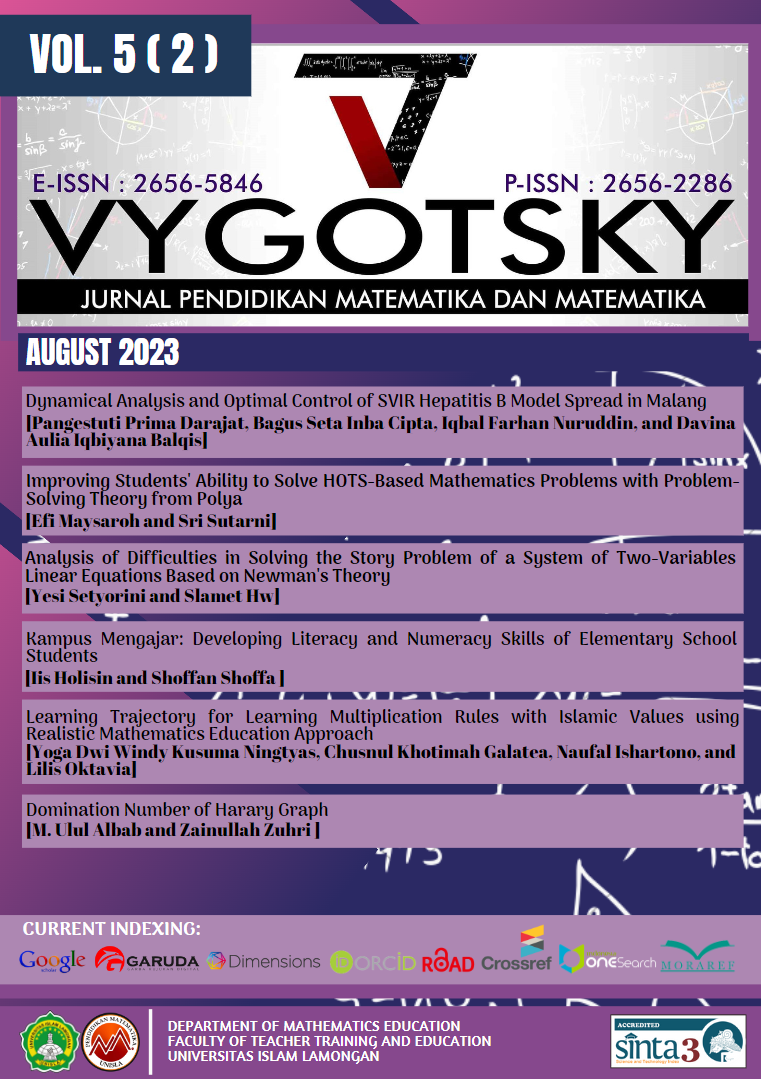Domination Number of Harary Graph
DOI:
https://doi.org/10.30736/voj.v5i2.866Keywords:
Dominating Set, Domination Number, k-Connected Graph, Harary GraphAbstract
The domination number of graph  is the smallest cardinality of the domination set of graph G. A subset of a vertex set S of G is called the domination set if every element of  dominates every vertex of G, meaning that every vertex of G that is not an element of S is connected and one distance from S. The domination number has become interesting research studies on several graphs k -connected such as circulant graphs, grids, and wheels. This study aims to determine domination number of the other k-connected graph is Harary graph. The method used pattern detection and axiomatic deduction. The obtained results are new lemmas and theorems. The discussion obtained challenges new patterns of the smallest of domination number of Harary Graph, especially shape H_2,n, H_4,n, H_k,n and  for every n vertices, k even integer, and k<n.Downloads
References
Alon, N., Balogh, J., Bollobás, B., & Szabó, T. (2002). Game domination number. Discrete Mathematics, 256(1–2), 23–33. https://doi.org/10.1016/S0012-365X(00)00358-7
Bonato, A., Lozier, M., Mitsche, D., Pérez-Giménez, X., & Prałat, P. (2015). The domination number of on-line social networks and random geometric graphs*. Lecture Notes in Computer Science (Including Subseries Lecture Notes in Artificial Intelligence and Lecture Notes in Bioinformatics), 9076, 150–163. https://doi.org/10.1007/978-3-319-17142-5_14
Chartrand, G., Haynes, T. W., Henning, M. A., & Zhang, P. (2019). From Domination to Coloring. http://link.springer.com/10.1007/978-3-030-31110-0
Chartrand, G., & Zhang, P. (2012). A First Course in Graph Theory. In Technometrics. Dover Publications, Inc. https://doi.org/10.1080/00401706.1988.10488342
Chudnovsky, M., Kim, R., Liu, C. H., Seymour, P., & Thomassé, S. (2018). Domination in tournaments. Journal of Combinatorial Theory. Series B, 130, 98–113. https://doi.org/10.1016/j.jctb.2017.10.001
Gonçalves, D., Pinlou, A., Rao, M., & Thomasse, S. (2011). The domination number of Grids*. SIAM J. Discrete Math., 25(3), 1443–1453. https://doi.org/10.1137/11082574
Gross, J. L., Yellen, J., & Anderson, M. (2019). Graph Theory and Its Applications (Third Edit). CRC Press.
Hao, G. (2017). On the domination number of digraphs. Ars Combin, 134, 51–60.
Harary, F. (1962). The maximum connectivity of a graph. Proc. Natl. Acad. Sci., U.S., 48, 1142–1146.
Haynes, T. W., Hedetniemi, S. T., & Henning, M. A. (2021). Models of Domination in Graphs. In Springer Cham (Vol. 66). https://doi.org/10.1007/978-3-030-51117-3_2
Haynes, T. W., Hedetniemi, S. T., & Henning, M. A. (2023). Domination in Graphs: Core Concepts. Springer Cham. https://doi.org/10.1007/978-3-031-09496-5
Haynes, T. W., Hedetniemi, S. T., & Slater, P. J. (1998). Fundamentals of Domination in Graphs. Marcel Dekker, Inc.
Henning, M. A., & Vuuren, J. H. van. (2022). Graph and Network Theory An Applied Approach using Mathematica. In Springer (Vol. 193, Issue C). Springer Nature Switzerland AG. https://doi.org/10.1016/S0167-5648(08)70928-6
Kalyan, K., & James, M. (2019). Domination Number of Sierpinski Cycle Graph of Order n. Journal of Computer and Mathematical Sciences, 10(4), 796–818. https://doi.org/10.29055/jcms/1066
Rad, N. J. (2009). Domination in Circulant Graphs. Analele Stiintifice Ale Universitatii Ovidius Constanta, Seria Matematica, 17(1), 169–176.
Saoub, K. R. (2021). Graph Theory : an introduction to proofs, algorithms, and applications. In Textbooks in Mathematics.
Snyder, K. (2011). c-Dominating Sets for Families of Graphs. University of Mary Washington. https://cas.umw.edu/dean/files/2011/10/KelsieSnyderMetamorphosis.pdf
Tanna, S. (2015). Broadcasting in Harary Graphs. Concordia University.
West, D. B. (2001). Introduction to Graph Theory (2nd Editio). Pearson Education, Inc.
Xu, K., & Li, X. (2018). On domination game stable graphs and domination game edge-critical graphs. Discrete Applied Mathematics, 250, 47–56. https://doi.org/10.1016/j.dam.2018.05.027
Downloads
Additional Files
Published
How to Cite
Issue
Section
License
Copyright:
Authors who publish their manuscripts in this Journal agree to the following conditions:
- Copyright of any article on Vygotsky: Jurnal Pendidikan Matematika dan Matematika is held solely by the author under the Creative Commons Attribution 4.0 International license (CC BY NC SA).
- Authors can submit papers separately, arrange non-exclusive distribution of manuscripts that have been published in this journal into other versions (e.g. sending to the author's institutional repository, publication in a book, etc.) by acknowledging that the manuscript has been published for the first time in Vygotsky: Jurnal Pendidikan Matematika dan Matematika.
License:
Vygotsky: Jurnal Pendidikan Matematika dan Matematika is published under the terms of the Creative Commons Attribution 4.0 International License (CC BY NC SA). This license permits anyone to copy and redistribute this material in any form or format, compile, modify and develop this material for any purpose as long as it is not for commercial purposes. Additionally, anyone must provide credit and distribute contributions under the license of the creator of the original work.











